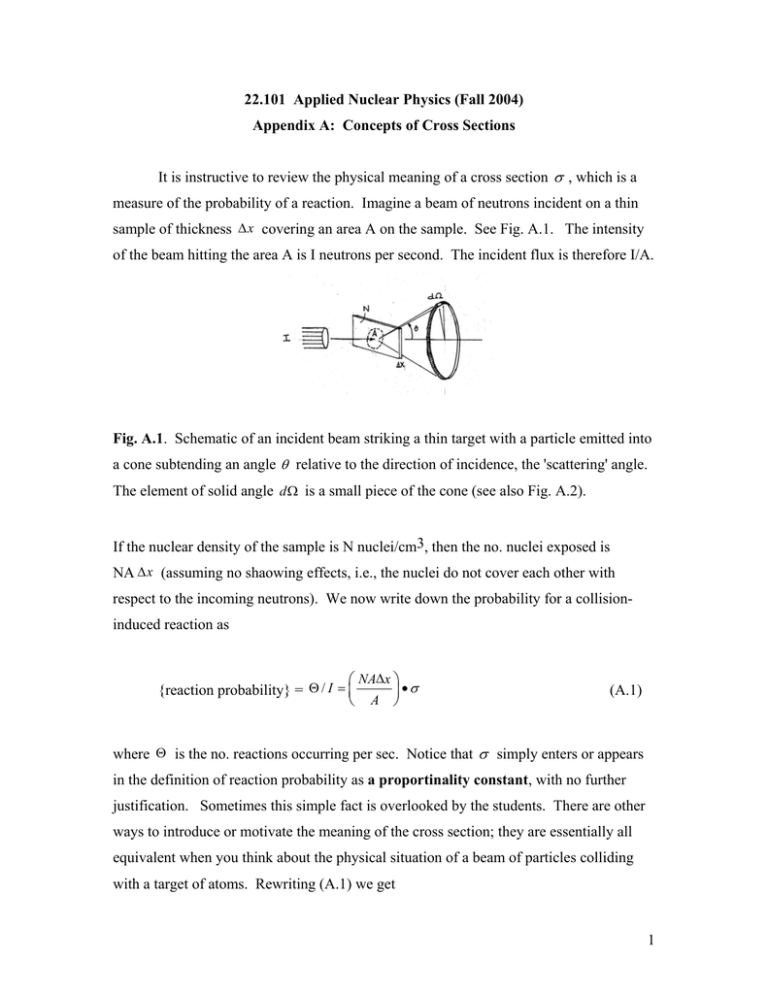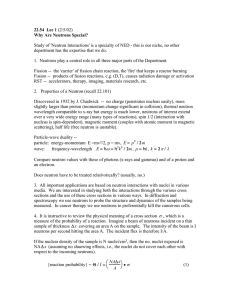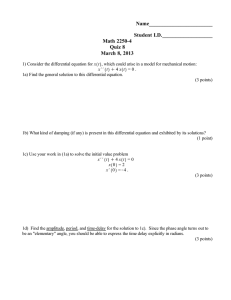σ
advertisement

22.101 Applied Nuclear Physics (Fall 2004)
Appendix A: Concepts of Cross Sections
It is instructive to review the physical meaning of a cross section σ , which is a
measure of the probability of a reaction. Imagine a beam of neutrons incident on a thin
sample of thickness ∆x covering an area A on the sample. See Fig. A.1. The intensity
of the beam hitting the area A is I neutrons per second. The incident flux is therefore I/A.
Fig. A.1. Schematic of an incident beam striking a thin target with a particle emitted into
a cone subtending an angle θ relative to the direction of incidence, the 'scattering' angle.
The element of solid angle dΩ is a small piece of the cone (see also Fig. A.2).
If the nuclear density of the sample is N nuclei/cm3, then the no. nuclei exposed is
NA ∆x (assuming no shaowing effects, i.e., the nuclei do not cover each other with
respect to the incoming neutrons). We now write down the probability for a collisioninduced reaction as
⎛ NA∆x ⎞
{reaction probability} = Θ / I = ⎜
⎟ •σ
⎝ A ⎠
(A.1)
where Θ is the no. reactions occurring per sec. Notice that σ simply enters or appears
in the definition of reaction probability as a proportinality constant, with no further
justification. Sometimes this simple fact is overlooked by the students. There are other
ways to introduce or motivate the meaning of the cross section; they are essentially all
equivalent when you think about the physical situation of a beam of particles colliding
with a target of atoms. Rewriting (A.1) we get
1
σ = {reaction probability} / {no. exposed per unit area}
=
Θ
IN ∆x
=
1⎡ Θ ⎤
I ⎢⎣ N ∆x ⎥⎦ ∆x→0
(A.2)
Moreover, we define Σ = Nσ , which is called the macroscopic cross section. Then (A.2)
becomes
Σ∆x =
or
Θ
I
,
Σ ≡ {probability per unit path for small path that a reaction will occur}
(A.3)
(A.4)
Both the microscopic cross section σ , which has the dimension of an area (unit of σ is
the barn which is 10-24 cm2 as already noted above) , and its counterpart, the
macroscopic cross section Σ , which has the dimension of reciprocal length, are
fundamental to our study of neutron interactions. Notice that this discussion can be
applied to any radiation or particle, there is nothing that is specific to neutrons.
We can readily extend the present discussion to an angular differential cross
section dσ / d Ω . Now we imagine counting the reactions per second in an angular cone
subtended at angle θ with respect to the direction of incidence (incoming particles), as
shown in Fig. A.1. Let d Ω be the element of solid angle, which is the small area through
which the unit vector Ω passes through (see Fig. A.2). Thus, dΩ = sin θ dθ dϕ .
2
Fig. A.2. The unit vector Ω in spherical coordinates, with θ and ϕ being the polar and
azimuthal angles respectively (R would be unity if the vector ends on the sphere).
We can write
⎛ dσ ⎞
⎜
⎟ = N ∆x ⎜
⎟
I ⎝ dΩ ⎠
⎝ dΩ ⎠
1 ⎛ dΘ ⎞
(A.5)
Notice that again dσ / d Ω appears as a proportionality constant between the reaction rate
per unit solid angle and a product of two simple factors specifying the interacting system
- the incient flux and the no, nuclei exposed (or the no, nuclei available for reaction).
∫
Note the condition dΩ(dσ/ dΩ) =σ , which makes it clear why dσ / dΩ is called the
angular differential cross section.
Another extension is to consider the incoming particles to have energy E and the
particles after reaction to have energy in dE' about E'. One can define in a similar way as
above an energy differential cross section, dσ / dE ' , which is a measure of the probability
of an incoming with incoming energy E will have as a result of the reaction outgoing
energy E'. Both dσ / dΩ and dσ / dE ' are distribution functions, the former is a
distribution in the variable Ω , the solid angle, whereas the latter is a distribution in E', the
energy after scattering. Their dimensions are barns per steradian and barns per unit
energy, respectively.
Combining the two extensions above from cross section to differential cross
2
sections, we can further extend to a double differential cross section d σ / dΩdE ' , which
is a quantity that has been studied extensively in thermal neutron scattering. This cross
section contains the most fundamental information about the structure and dynamics of
2
the scattering sample. While d σ / d ΩdE ' is a distribution in two variables, the solid
angle and the energy after scattering, it is not a distribution in E, the energy before
scattering.
3
In 22.106 we will be concerned with all three types of cross sections, σ , the two
differential cross sections., and the double differential cross section for neutrons, whereas
the double differential cross section is beyond the scope of 22.101.
There are many important applications which are based on neutron interactions
with nuclei in various media. We are interested in both the cross sections and the use of
these cross sections in various ways. In diffraction and spectroscopy we use neutrons to
probe the structure and dynamics of the samples being measured. In cancer therapy we
use neutrons to preferentially kill the cancerous cells. Both involve a single collision
event between the neutron and a nucleus, for which a knowledge of the cross section is
all that required so long as the neutron is concerned. In contrast, for reactor and other
nuclear applications one is interested in the effects of a sequence of collisions or multiple
collisions, in which case knowing only the cross section is not sufficient. One needs to
follow the neutrons as they undergo many collisions in the media of interest. This then
requires the study of neutron transport - the distribution of neutrons in configuration
space, direction of travel, and energy. In 22.106 we will treat transport in two ways,
theoretical discussion and direct simulation using the Monte Carlo method, and the
general purpose code MCNP (Monte Carlo Neutron and Photon).
4





